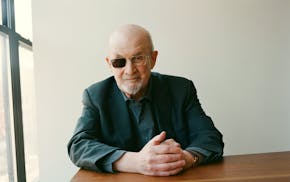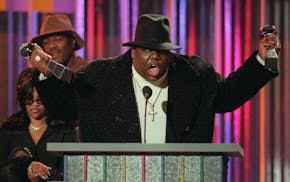Students in the journalism class at North High School are telling stories no one else is chasing in hopes of bringing readers a richer understanding of their Minneapolis neighborhood.
The classroom's 21 students aren't just learning the basics of reporting and journalism ethics. Through an unusual collaboration, North News Editor Kenzie O'Keefe co-teaches the class, publishing some of the student work in her 10,000-circulation newspaper or on the publication's website. She also hires some of the students as paid interns who join the paper's tiny staff, comprising O-Keefe and two part-time reporters, along with three freelancers who design, copy edit and deliver the paper.
O'Keefe said the educational outreach is part of the monthly newspaper's philosophy of involving the community in telling its own story.
In that spirit, O'Keefe pointed to her students to talk about the effort.
"There's a lot of stuff going on here that people don't even know about," said sophomore Melvina Manciel, whose rap name is Lil Mello. On a recent Friday, Manciel was working on an article about up-and-coming musicians in the neighborhood. Manciel recently posted her first album to her YouTube channel. She's performed not just at North High talent shows but also at gigs in New York City.
What usually gets reported in the local press about her community, Manciel says, is crime — part of the reality in an area hurt by generational poverty and rising numbers of residents made homeless as Twin Cities housing prices rise further out of reach. But when the students huddle for their story meetings, they pitch stories on culture and sports, and propose ideas grounded in their own experience, like a piece about lead leaching from pipes in nearby homes.
The most prolific writers this year are North High seniors Howard Hadley Jr. and David Snoddy Jr., both seniors who also work as paid interns. They cover the Polars men's basketball team at North, attending every game and co-writing dispatches. Neither had much interest in journalism before taking the class, they say. But after seeing people enthusiastically flip to their articles each month, they're both considering it as a possible career.
The students have taken field trips to area newsrooms and attended journalism conferences hosted by the University of Minnesota, said Samuel Wilbur, who co-teaches at North with O'Keefe and is a graduate of the University of Minnesota's journalism program.
"Anytime we go to an event, our students really shine," he said. "They stand up and ask truthful, hard-hitting questions that others aren't asking."
The student writers are part of a reinvention of North News that began in 2015, when the nonprofit Pillsbury United Communities bought the struggling newspaper.
"They wanted the news source itself to be something that deeply resonated with the diverse community that lives on the north side," said O'Keefe, who was hired at the time to lead the effort. To do that, she has looked for ways to embed in the community.
Her staff reporters, for example, typically work out of Sammy's Avenue Eatery, a popular neighborhood coffee shop, or other local haunts rather than at the paper's official one-room office in Pillsbury Community Center.
The newspaper also involves sources as partners in stories in ways that challenge long-standing journalistic practices. O'Keefe and other North News reporters routinely show articles to sources before publication, which is frowned on in traditional newsrooms for fear that sources will try to remove unflattering details. O'Keefe said she never promises any changes, but she wants to hear about anything that might be unintentionally insensitive or stereotypical.
"I'm a white woman. I grew up in the Twin Cities, but not on the north side," said O'Keefe, who is 29. "I feel a tension as the editor of this paper between the real need to amplify all the good stuff that's happening in north Minneapolis — because there's tons of it — and also the pressure I feel as a journalist in a community that's under-reported-on to investigate some of the most challenging portions of life here."
One project by youth reporters that she's most proud of is the "Trauma Troopers" series published in 2018, in which young reporters interviewed 55 of their peers about the psychological challenges of witnessing violence and oppression.
In the introduction to the series, the reporters wrote, "Our youth need more outlets like this one, where they can freely express how they feel and the things they are going through. Trauma is getting worse. Teenagers need help. People are dying. We need more programs and resources. Youth need better advocacy."
The approach seems to be winning over readers. TeCara Ayler, a 41-year-old small business owner living on the north side, said she likes the paper because it's full of "real people you see" in the neighborhood.
"My son's mentor was just [quoted] in here," she said. "Kenzie came to my house and talked to me about my issues" for a recent story on housing instability, she added.
The students make videos, too, which are shown to classmates in the school's equivalent of homeroom.
North News is part of a nationwide trend in rethinking how community newsrooms operate.
In Oakland, Calif., the nonprofit newspaper Berkeleyside recently won a $1.5 million grant from the Google News Initiative to launch an online platform that will publish more daily news while collaborating with agencies and nonprofits working to improve life in the community.
The premise, wrote the editor-in-chief of the new effort, Tasneem Raja, is that readers "don't just want breaking news about crises and tragedies; they also want more equitable, informed reporting on root causes. They want more opportunities to tell their own stories and shift harmful narratives, and to see the value of their communities reflected in local reporting."
At North News, O'Keefe said she has been contacted by leaders of other small community newspapers who want to learn more about her model to help shore up their own struggling operations and have a greater impact.
O'Keefe understands that most students in her class will not go on to become journalists, but she feels that journalism training can help build leadership skills and community awareness. North High School did not have a course in journalism when she proposed partnering with the school soon after she started at the newspaper.
Azhae'la Hanson, one of the first students to go through the journalism course, is now a sophomore at Xavier University of Louisiana, in New Orleans. She's majoring in education, but she spends much of her free time writing articles and taking photographs for the student newspaper, the Xavier Herald.
"There are a lot of times when big journalism can hurt communities — even by being very vague and not knowing what's going on," she said. "I would prefer a paper that's coming from my community who knows what's going on," she said, noting that was the goal of North News.
The class at North opened doors for her, she said. "I was able to get a grant and buy all of my photography equipment," she said. O'Keefe still contacts her with leads on potential jobs and opportunities.
On a personal level, O'Keefe hopes that her efforts in the classroom eventually put her out of a job.
"My dream is that a student would come up through our program, go to college, have a ton of life experience and want to come back and lead this paper," she said.
"A really just outcome of the life span of North News would be for one of our [former] participants to come back and lead this program."
Jeffrey R. Young of St. Paul is an education journalist currently working for EdSurge, a national publication covering the intersection of education and technology.
NPR suspends editor who criticized his employer for what he calls an unquestioned liberal worldview

Salman Rushdie's 'Knife' is unflinching about his brutal stabbing and uncanny in its vital spirit

